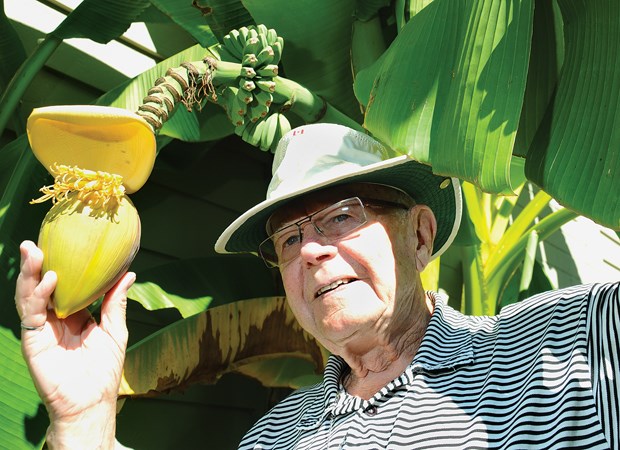There was a story recently on the CBC about a gardener in Abbotsford growing a banana plant that actually produced some small bananas.
Given that Abbotsford's microclimate can range five or six degrees warmer in the summer than the North Shore's climate, it is possible for some tropical plants to bear fruit there during long, hot summers. You may however be surprised to know that District of North Vancouver resident Bill Riley has also grown bananas that produce fruit. If Riley lived in Ambleside or somewhere else down near the warming effect of the ocean it may not be such an impressive feat. However, Riley lives in the cooler temperatures of the Capilano Highlands at 235 metres above sea level, which makes his accomplishment noteworthy.
I spoke with Riley at his home while we looked at his burgeoning colony of bananas (Musa species). Riley's bananas are planted on the southwest side of his home right up against the house, chimney and under the roof overhang. His planting location receives full sun most of the day and the sun's solar heat is absorbed and radiated by the house and the chimney, which creates a microclimate for the bananas to grow.
One of the tricks to growing tender plants in our temperate northern climate involves choosing a planting location that is protected from wind with full sun exposure and preferably situated against a building or other structure that can collect and radiate heat from the sun. Such locations create a microclimate within the surrounding locale to provide the warmth required by tropical and other tender plants to flourish in summer and survive cold winter temperatures.
Riley is a spry 87 years young with a keen memory for details and an enthusiasm for life. We talked about a wide range of topics including making way too much homemade wine with the Mussatto family some years ago, his life during and after the Second World War and his affection for his bananas, which have become a hobby for him during retirement.
"My plant has produced small bananas over the last few years. But none of them have ripened enough to be edible because our season is not long enough for ripening," he told me while we stood looking at a large bulbous flower head surrounded by rows of small bananas.
Riley is a retired petroleum engineer and geologist who likes a challenge. He was given his first banana plant by Johnny Mussatto, uncle of City of North Vancouver Mayor Darrell Mussatto. Riley started his plant some seven years ago from a small one foot plant. His plant is now approximately 4.8 m tall and the top leaves almost touch the roof of his two-storey house. The plant's largest leaves are almost 1.5 m long with some stalks almost as thick as my leg.
I have seen bigger colonies of banana plants growing on the North Shore and farther afield but few if any of those plants produce fruit. I assumed Riley put significant effort into growing his bananas but he said, "I water them and feed a small amount of fertilizer two or three times per season and that's about all I do."
He does not mulch or dress the soil with organic matter. When it comes to winter protection, Riley told me he cuts off all the leaves and piles them around the base of the plants and covers the whole colony with a tarp to protect the plants from the cold winter weather. Since his plant is located right up against the house and chimney, the radiant heat from the house helps keep the plants warm during winter. And rain protection from the roof overhang helps keep the plant dry and lessens the effect of freezing winter temperatures. Dry soil is less likely to freeze and therefore the plant is less likely to be frost-damaged during winter.
Interestingly, while I was looking at his banana plant, there were yellow jacket hornets feeding on the pollen of the banana flowers. Riley believes that various bees and ants have helped to pollinate his bananas. The pollination by native insects on his banana plant clearly demonstrates that non-native plants are fed on and pollinated by native insects. Such ecological interactions are contrary to the claims of the invasive species people who claim that non-native plants do not provide food for native insects. But I digress.
The burning question in my mind: Why would he grow such large and maintenance heavy plants?
"It's like Mount Everest -just because it's there," he said with a smile. "It's a matter of bragging rights. We are not just a bunch of pretty faces here in North Vancouver, we can grow real bananas."
Todd Major is a journeyman horticulturist, garden designer and builder, teacher and organic advocate. [email protected]



